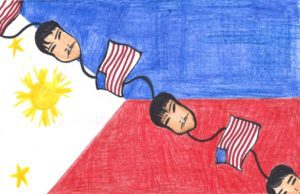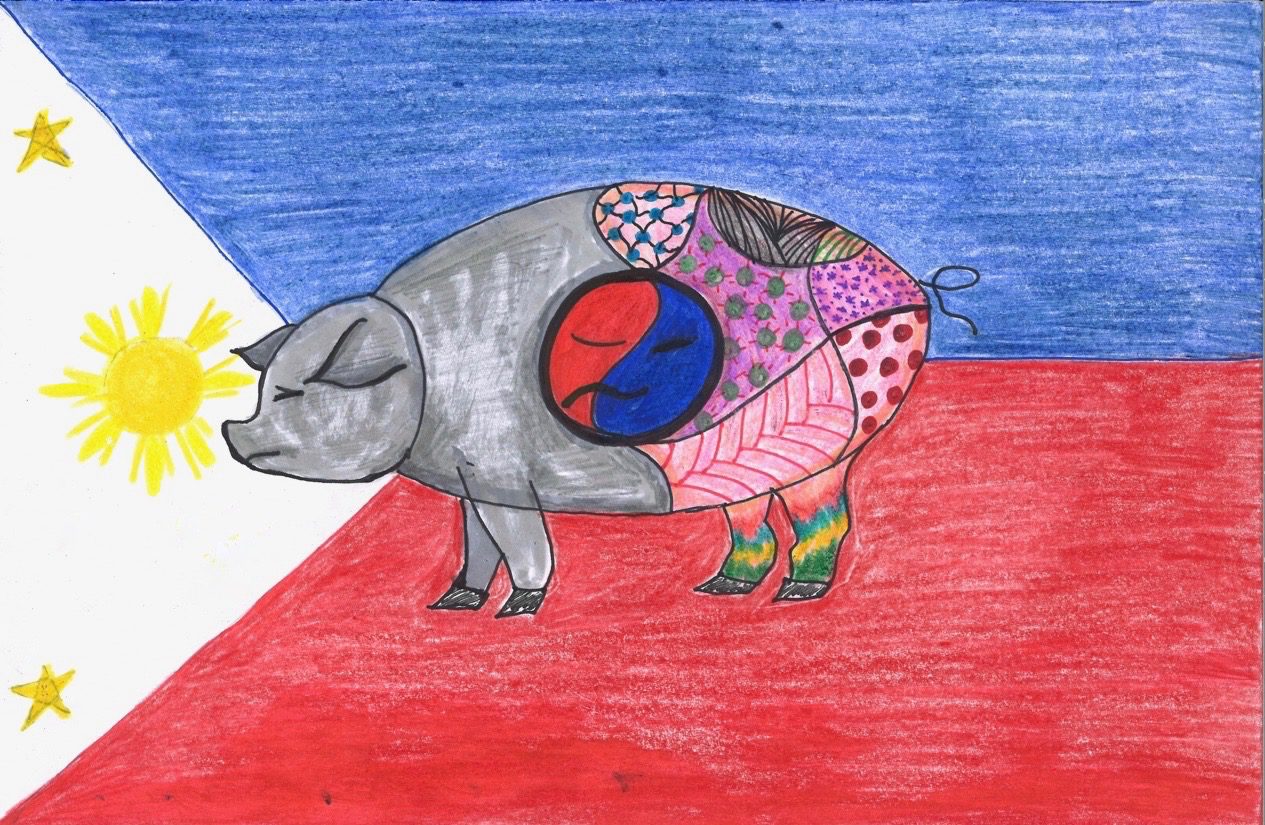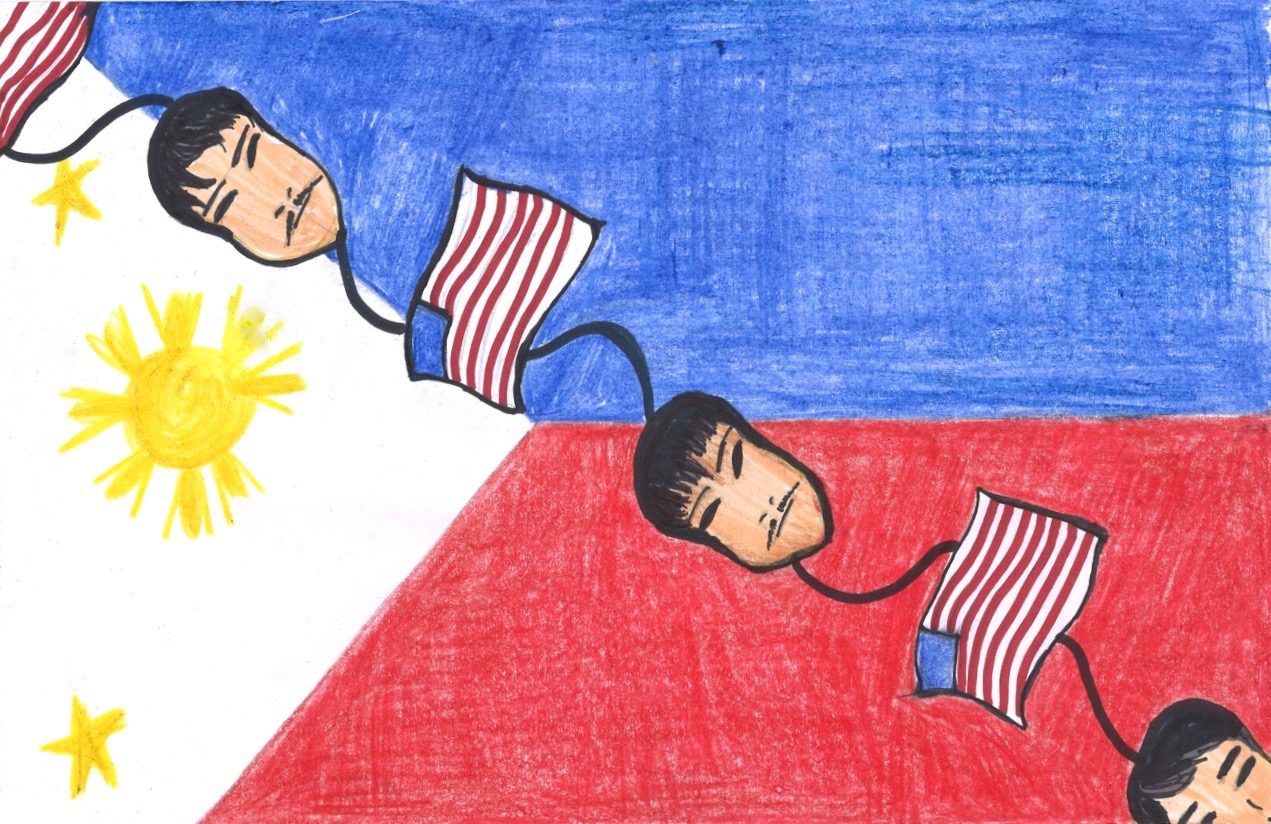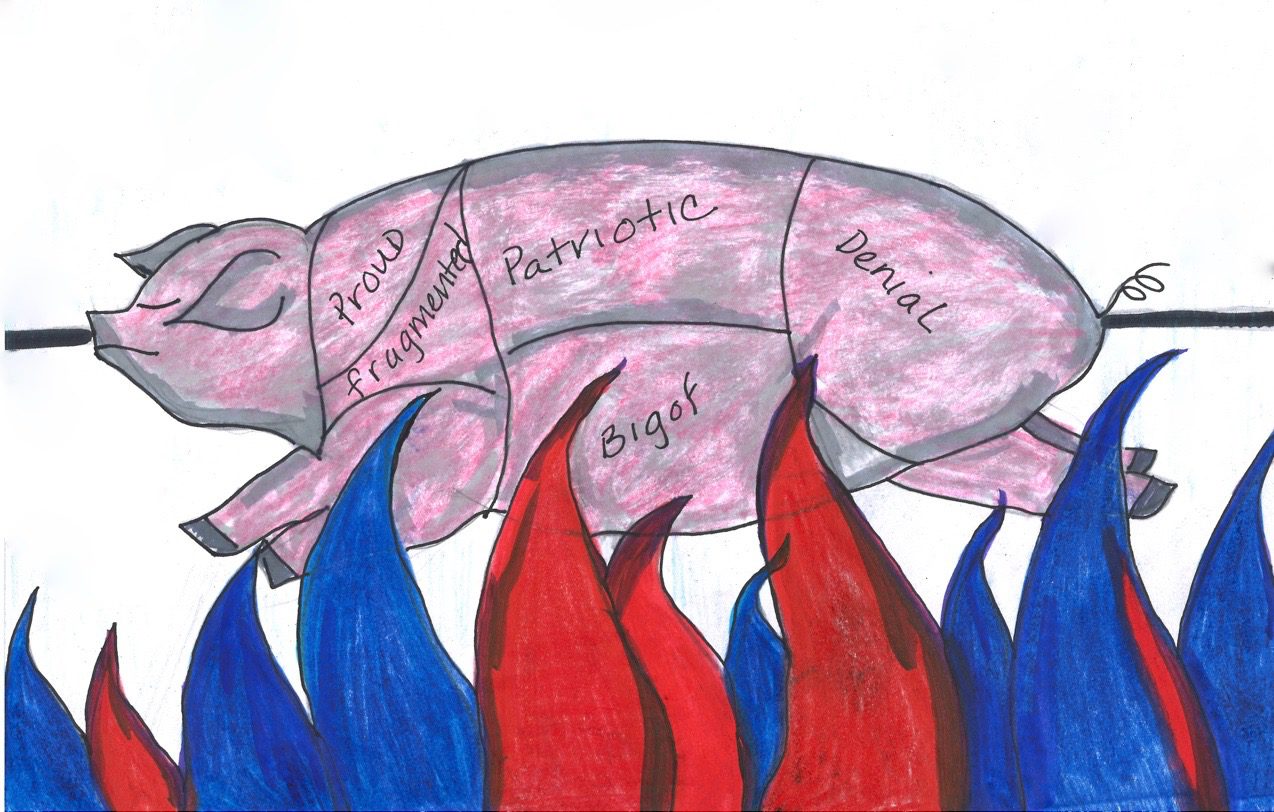
There’s a fine line between speed and sloppiness when you’re preparing meat on a stick. I made the mistake of moving too quickly, knowing we had close to one hundred pounds of sliced pork to get through. I plucked the bamboo splinter from my hand, washed the wound, and went back to work.
As a teenager, I’d spend nearly every Labor Day weekend at my dad’s house where we’d slice, marinate, skewer, and package pork barbecue for the annual neighborhood block party. His dish was considered a fan favorite with up to five hundred servings being devoured each year. So naturally, when our newest neighbors announced they’d be roasting an entire pig, he insisted we make as many skewers as possible. My Filipino father refused to be upstaged by a white man’s lechon.
My fingertips wilted after the first hundred sticks. Washing my hands in between batches seemed pointless, but after hours of handling refrigerated pork, they needed some source of warmth. I cranked the kitchen faucet to the left and flexed my fingers under its running water while picking out the minced garlic wedged beneath my nails. This moment of rest was fleeting. I could smell the mixture of soy sauce and vinegar as my dad assembled another batch of marinade for the next round. I stood beside him to add a few generous scoops of brown sugar. He could tell I knew the recipe by heart.
I’d missed the previous block party, having spent last Labor Day with my mom.
“You should’ve seen it,” Dad exclaimed. “It was like Woodstock over here!” He went into detail. The hungry and overwhelming crowd, the hundreds of skewers he made, and the fact that they were consumed in minutes. No matter how many times he repeated the story, I always let him tell me again. I enjoyed watching his face light up.
It was a sight I rarely saw after the divorce.
As we assembled the next batch of sticks, Dad recalled a moment from the block party he hadn’t mentioned before. He complained about a Filipina who wasn’t one of our guests.
“She walks by my grill, and you know what she says to me? ‘Oh! I smell Pilipino barbecue!’” He elongated his vowels to make fun of the woman’s fresh-off-the-boat accent. Then, he recounted his response, “‘Lady, that’s not Filipino barbecue. That’s my barbecue.’”
Dad’s connection to Philippine culture was likely abandoned during his childhood. Before the age of two, he immigrated from Manila to America with my grandparents. They thanked this country for everything it had to offer them: A home in the suburbs of New Jersey, careers with steady paychecks, and an American education for their children. In the 1960s, the United States expected them to express their gratitude by trading in their Pinoy identity for white American culture. So, they cast it aside and their kids did the same.
My father grew up packing baloney sandwiches so his classmates wouldn’t call him a gook. He voted for Ronald Reagan when he made enough money to be considered a yuppie. He said going to Iraq wasn’t a matter of being pro-war but what he labeled pro-American. Rooted in survival, his identity as an American grew into pride and eventually bloomed into dogma, so he instilled in me a fundamental truth: We weren’t Filipino-American. We were American first and Filipino when necessary.
This certainty was easy for me to accept. Not only did I grow up with little connection to Pinoy culture, but I also embraced my father’s opinions as facts. Dad was the cool parent—the one who raised me on Marvel comics and let me watch South Park. I idolized him. It wasn’t until I was well into my adulthood that I’d see the flaws in his beliefs and learn that Philippine roots could in fact coexist with an American identity.
My stepmother chimed in, “Sweetie! Take that back.” She playfully interrupted Dad’s anecdote as she continued slicing strips of pork across from him. “It’s my barbecue. Not yours.”
When he begrudgingly agreed, Tita Millet gave me a wink. She loved putting him in his place. Dad may have been the grill master, but Tita Millet was the source of the marinade.
Adjectives describing the word stepmother were generally negative in the Disney movies, TV sitcoms, and after-school specials I had watched as a child. But Millet never fell into the category of evil or wicked. I called her tita. The Tagalog term translated to aunt, but it was also used for any woman deemed as family.
The title provided a graceful alternative to stepmother, a label sounding derogatory to Filipino-Catholics who didn’t care to be reminded about the implications of divorce. This salutation also called for the same degree of respect one would show to any blood-related relative. Tita Millet saw my dad through a divorce, built a home with him, and agreed to marry him. She earned this title, and I loved her for it.
The end of the divorce had coincided with my early teenage years, a time in which children grow up to grasp the meaning of the word spite. During the hour-long car rides from my mother’s apartment to my father’s house, Dad and I would occasionally pass the time by mutually venting about Mom. We’d form a chorus and play into our respective clichés—Dad as the bitter divorcée, me as the resentful child.
“Mom doesn’t want to buy me an iPod,” I complained. “She says they’re too expensive.”
“Figures. Your mom’s Filipino. They’re all cheap.”
A degree of separation would always exist between my American father and native Filipinos like my mother. He felt different from them. As the first person in our family to be raised in the States, he wore the title of American citizen with pride. That involved trading in Tagalog for English and replacing Pinoy culture with stateside values.
Like any good American, he believed in hard work and people like my grandparents who “pulled themselves by their bootstraps.” He had little sympathy for the Filipinos fourteen thousand miles away who he believed were too lazy to do the same. He didn’t care to understand them, but when he tried to, he relied on generalizations.
Simplified versions of an ethnicity were much easier to comprehend than the complexities of people. This method became his way of rationalizing anyone’s behavior. If his friend didn’t like spicy food, it was because he was Polish. If his neighbor kept to himself, it was because he was Jewish. If his coworker liked colorful handbags, it was because she was Ghanaian.
However, he seemed to attribute the worst behaviors to Pinoys. If someone divorced their husband, cheated on their wife, had a second family, stole from their family, bankrupted a business, couldn’t find a job, failed their exams, or did anything that was just plain stupid, it was because they were Filipino.
My dad’s explanations became more adamant after the divorce. They were his personal blend of heartbreak and spite as he tried making sense out of my mom’s choice to leave him—an event that only confirmed his worst suspicions of Filipinos. Between the demise of his marriage and the pressures of his childhood, my father repeatedly traced his pain back to his Philippine identity.
I comforted him by nodding along and adopting his views as my own. It was easy to follow his logic. It was convenient to boil down the divorce to cultural flaws. It was simple to blame my ethnicity in order to rationalize the parts of my life I didn’t understand.
As a teenager, a bullshit explanation sounded better than no explanation at all. As an adult, I’d learn that explanations are rarely that simple. I’d understand how my mom fell out of love, how she made a difficult choice to be happy, and how cultural differences had little to do with any of it.
After we finished the last batch of barbecue, Dad wiped down the kitchen counter and any residue of brown marinade left behind. While he did, I looked up the traditional barbecue mentioned by last year’s guest and compared it to the recipe I knew by heart. I noticed Dad made a few modifications. Banana ketchup was replaced with traditional Heinz, oyster sauce with steak sauce, and red chili peppers with a generous pour of Tabasco. The Americanized concoction formed a sweet-yet-tangy-yet-spicy marinade he only used on sliced pork loin. Dad prided himself on not skimping out on the good stuff—not like those “cheap Pinoy restaurants”—so he refused to label our assembled pork skewers as Filipino barbecue.
As I helped Dad clean up, I admired the sight of him and Tita Millet working side by side. Falling in love with another native Filipina was the last thing I expected him to do. But Tita Millet wasn’t just Pinay; she was also Chinese. My father embraced this trait harder than the ethnicity all of us shared. To him, Chinese people didn’t mess up. They were “the Asians who got it right.” This pecking order is best stated by Chinese-Vietnamese comedienne Ali Wong: “The Fancy Asians are the Chinese, the Japanese. They get to do fancy things like host Olympics. Jungle Asians host diseases.”
My mother was a full Jungle Asian and a native Filipina. Tita Millet was mixed: half Pinay and half Chinese. Her Fancy Asian influence redeemed her from Jungle Asian downfalls. My father trumped both of them by being an American.
I took note of the home Dad and Tita Millet had made for themselves. The house had a colonial exterior, but the inside was adorned with growing bamboo, jade pendants, big-bellied Buddhas, red carpets, gold-accented vases, and foreign calligraphy whose meaning remained unknown to me, Dad, and even Tita Millet. Each of these elements were curated to follow Feng Shui in order to bring balance and harmony to their household. This Chinese practice of interior decorating didn’t believe in a Lazy Susan on the table, giant wooden utensils in the kitchen, or a pitcher of Tang in the fridge.
As I helped my parents clean the kitchen, I moved the trays of completed barbecue sticks onto their black-lacquered dining table. I noticed it had a glass cover that protected its gold-painted orchids from any potential spills from the marinated pork. The delicate floral designs continued onto the backs of the matching chairs featuring high-society women. They donned traditional Chinese robes, porcelain skin, and straight hair perfectly swept up into a bun. Their faces were ethereal and powdered to symbolize dignity and grace, but they looked nothing like mine.
After we completed one thousand pork skewers, Dad promptly called bullshit on our new neighbors’ plans to roast an entire pig for the block party. “They think they’re hot shots by doing all that? Those white people don’t know what the hell they’re up against,” he laughed. “Ever gone to a pig roast? It’s a whole day affair! Do you see any smoke by their house? I don’t! No way they’ll be ready by tomorrow.”
In some cases, my dad couldn’t deny the lessons of his skin. We weren’t white. We were brown. We knew a thing or two about roasting a pig. Dad understood that, so as much as he criticized native Filipinos, he never fully identified with white Americans either. I laughed along with his rant, but I was never certain where his words left us. Somewhere in the middle, perhaps. Somewhere between Asians and whites. Some perfect place where we could exist—the best American qualities wrapped in Filipino skin.
Our neighbors Tom and Maryanne were a newlywed couple who looked like a cross between King of Queens and an LL Bean catalogue. They came from the Catskills but maintained a New York City bravado. They had no trouble greeting my dad and Tita Millet in their meticulously curated home, only to comment on the porch and say how it looked a bit shoddy. But, it was okay. They had a guy up in Hunter who could fix it up right away.
Underhanded remarks like that never went unnoticed with my father. To him, they were more than insults. They were threats to the all-American image he had created. Our white neighbors often made these remarks, not knowing Asians were instinctively trained in the fine art of grudge-holding. Dad remembered Tom and Maryanne’s comments. He remembered Annie’s complaints about the price of Asian cuisine, which didn’t fill her up like “real food.” He remembered Don’s form of gratitude when my dad helped fix his computer—a single carton of lo mein. Ignorance seemed to be par for the course in our neighborhood.
All of the adults had opinions on Asian culture, and as a budding teen, I was listening. Between my dad’s criticisms and my neighbors’ comments, I was disheartened by the supposed consensus that my ethnicity was incapable of being celebrated or even respected. Much like my father, I remembered their remarks and took them in while remaining outwardly silent on the matter.
That Labor Day, the Stars and Stripes waved in the distance while my dad and the rest of the men fired up their grills in the middle of the cul-de-sac. Our pork skewers sizzled as they were laid down one by one with marinade dripping onto the flames. While I assembled red, white, and blue cutlery, I watched each household place their own slice of Americana onto the main table.
The Clemmons were known for barbecued chicken thighs with charred, crispy skin that trapped in flavor. The Demas for grilled fillets of chicken breast that other neighbors quietly compared to rubber. The Gugliches usually covered hamburgers and hotdogs along with kielbasa, in recognition of their Polish roots. The DiNizos provided a full Italian spread of penne, antipasto, and fruitti di mare, which would be the extent of culinary diversity. Dad’s tray of barbecue sticks fit in perfectly.
On the buffet line that formed, guests were none the wiser when it came to the origin of his barbecue. As far as they were concerned, his contribution was as American as Reaganomics. My father smiled, standing back in satisfaction, and I smiled with him. It wasn’t until I got older that I’d wish I had the courage to tell people the origin of our recipe so that Pinoy barbecue could be acknowledged as much as Italian pasta.
When I heard some commotion coming from Tom and Maryanne’s house, I wove through the crowd of neighbors, guests, guests of guests, and complete strangers. I joined the spectators who watched the newlyweds heave a large metal contraption up their driveway. Dad offered to help, but Tom declined, reassuring they had it under control. I watched my father stand aside as the couple parked an oversized smoker next to the grills.
Dad used to tell me about the roasts he attended whenever he’d visit family in the Philippines. The physical labor it took to build a proper outdoor spit. The patience an evenly roasted pig demanded. The pride a neighborhood showed when they had the means to afford lechon.
When Tom and Maryanne lifted the lid, a blackened cloud suddenly appeared as if to cue some sort of magic act. It revealed a pig whose corpse formed an unnatural color gradient. On one end, red piping hot flesh that looked ready to burst. On the other, greyish ashen skin that began to crumble. Tom and Maryanne laughed to themselves in a self-deprecating way I could almost appreciate. Then, they hacked away at the partially cooked animal. They cooked it by flipping it like a buttermilk pancake. They served the parts of it they deemed fit.
“Filipinos go nuts over this stuff,” Tom said.
By the end of the block party, our barbecue sticks were gone, and our neighbors called it quits with their inedible lechon. Tom ceremoniously ended the roast with the help of his guests. Together, they severed the pig’s head and laughed as they hung it from a tiki torch. I had seen a pig’s head before whenever lechon was served at Filipino parties, birthdays, and weddings. No one was ever grossed out by it. The roasted pig looked pristine with a golden-brown color throughout and thin, crispy skin that could crack with even the slightest touch. It was presented at the main table symbolizing prosperity and pride.
This pig’s flesh fell out from its head, with a few tendrils hovering over Tom’s fresh-cut lawn. I stared at it. I mourned the animal. Its blackened skin and fleshy blotches on display.
When my dad saw it, he scowled and noticed Tom and his friends laughing. He wanted to say something. Dad was never short on opinions. I couldn’t tell whether he’d call out our neighbors’ ignorance or unload on their inept culinary skills. However, I also knew he was conflicted. I felt it in myself as I wondered what to make of the pig on a stick. A symbol of Philippine pride that my white neighbors had picked apart and hung from a tiki torch.
“Filipinos go nuts over this stuff,” Tom said again.
“No,” Dad replied, “I don’t think we do.”
This curt response allowed him to state his case while avoiding further conflict. These were the parameters his American upbringing had taught him to operate within. Proud but not too proud. Ethnic but not too ethnic. Filipino but not too Filipino.
And yet, these few words from my father spoke volumes to me. They encouraged me to believe our ethnicity was worth defending—and that we couldn’t simply remain silent. While it would take time for me to strengthen this belief, my voice eventually became louder than a curt response. And as an adult, I’d come to fully embrace my Philippine identity. Until then, I followed my dad as we walked away from our neighbors and rolled his exhausted grill back up our driveway.
***
Rumpus original art by Leesa Travis.







